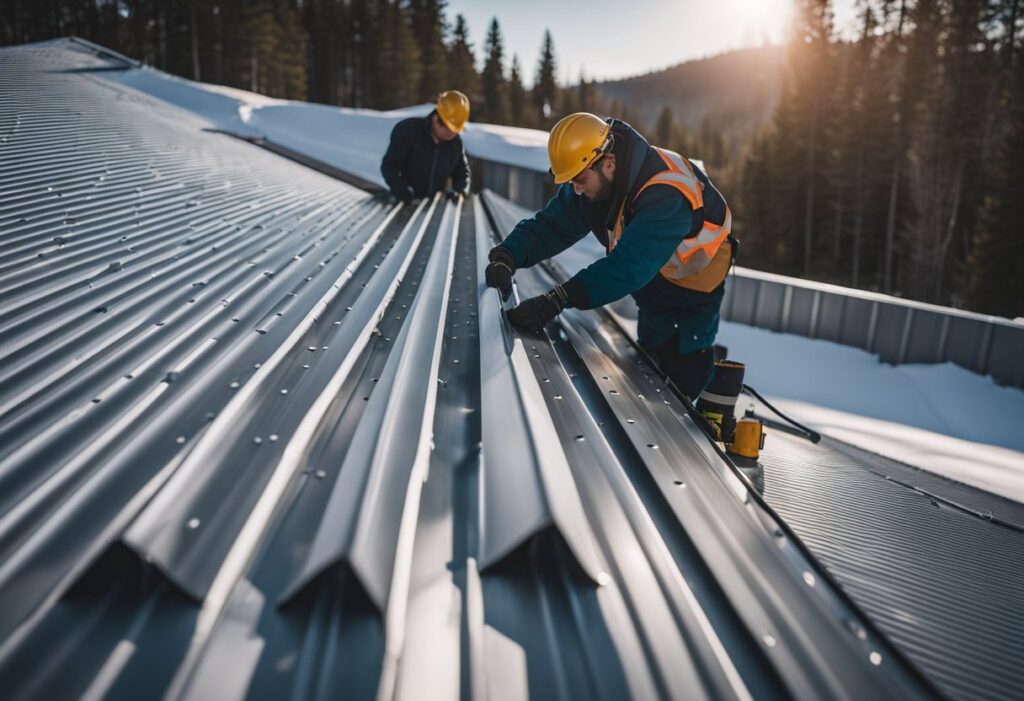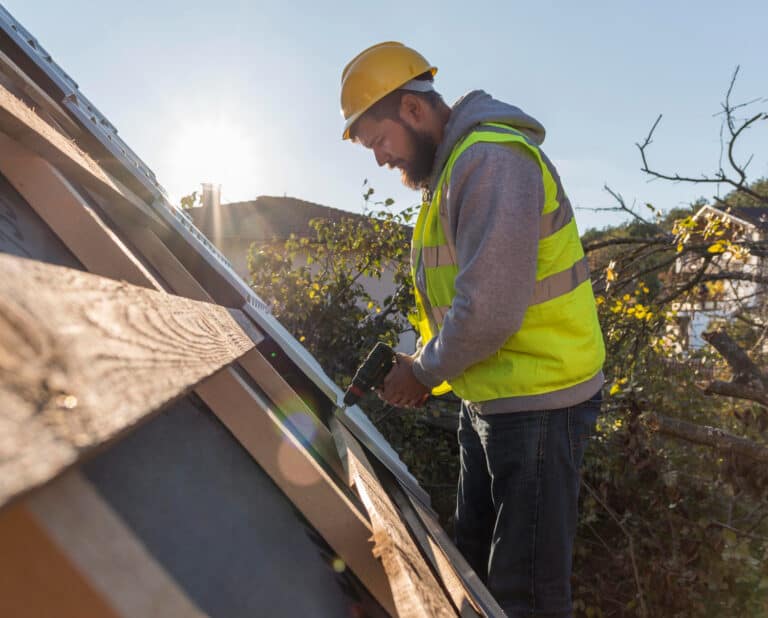Snow guards are an essential component that prevents snow and ice from sliding off of a standing seam metal roof. The primary purpose of snow guards is to protect people, pets, and property from falling snow and ice. They also help to prevent damage to the roof and gutter system caused by the weight of accumulated snow and ice.

Standing seam metal roofs are a popular choice for commercial and residential buildings due to their durability, energy efficiency, and aesthetic appeal. However, without proper snow retention, they can pose a significant safety hazard during the winter months. Snow guards are installed on the roof’s surface to create friction, which helps to hold the snow and ice in place until it can melt or safely slide off in small amounts.
There are several types of snow guards available in the market, including pad-style guards, snow bars, and rail-type snow retention systems. The type of snow guard used depends on the roof’s style, pitch, and the amount of snow and ice that the area receives. In general, it is recommended to install snow guards in areas that receive more than 6 inches of snowfall per year.
Importance of Snow Guards for Standing Seam Metal Roofs

Standing seam metal roofs are a popular choice for their durability, longevity, and low maintenance. However, they are also prone to snow avalanches, which can cause damage to property and pose a safety hazard to people. Snow guards are an essential component of standing seam metal roofs that prevent snow buildup and avalanches.
Prevention of Snow Avalanches
Snow guards prevent snow from sliding off the roof in large amounts. This is important because snow avalanches can cause significant damage to property and pose a safety hazard to people. Without snow guards, snow can accumulate on the roof and then suddenly slide off, causing damage to gutters, landscaping, and other property. Snow guards hold the snow in place until it can melt slowly and safely.
Protection of People and Property
Snow avalanches can pose a safety hazard to people, especially if they are standing or walking near the building. Falling snow and ice can cause serious injuries and even fatalities. Snow guards protect people by preventing snow from sliding off the roof in large amounts. They also protect property by preventing damage to gutters, landscaping, and other property.
Enhancement of Roof Longevity
Snow and ice can cause damage to standing seam metal roofs over time. Snow guards protect the roof by preventing damage from snow and ice buildup. Without snow guards, the weight of the snow and ice can cause the roof to buckle or warp, leading to leaks and other damage. Snow guards also prevent damage to the roof by preventing sliding snow and ice from hitting and damaging the roof.
In conclusion, snow guards are an essential component of standing seam metal roofs that prevent snow buildup and avalanches. They protect people and property, enhance roof longevity, and prevent damage from snow and ice buildup.
Types of Snow Guards for Standing Seam Roofs

When it comes to preventing snow and ice from sliding off of a standing seam metal roof, there are several types of snow guards available. Here are three popular types of snow guards for standing seam roofs:
Pad-Style Snow Guards
Pad-style snow guards are the most common type of snow guard for standing seam roofs. They are made of polycarbonate or metal and are attached to the roof with adhesive. They are designed to hold snow and ice in place until it can melt or evaporate. Pad-style snow guards are relatively inexpensive and easy to install.
Rail System Snow Guards
Rail system snow guards are another popular type of snow guard for standing seam roofs. They consist of a series of rails that are attached to the roof with screws. The rails are designed to hold snow and ice in place until it can melt or evaporate. Rail system snow guards are more expensive than pad-style snow guards, but they are also more durable.
Clamp-On Snow Guards
Clamp-on snow guards are a third type of snow guard that can be used on standing seam roofs. They are attached to the roof with clamps that are designed to fit over the seams of the roof. Clamp-on snow guards are relatively easy to install and are less expensive than rail system snow guards. However, they are also less durable and may need to be replaced more frequently.
Overall, the type of snow guard that is best for a standing seam metal roof will depend on a variety of factors, including the slope of the roof, the amount of snow and ice that typically accumulates on the roof, and the budget for the project. It is important to choose a snow guard that is appropriate for the specific needs of the roof to ensure that it provides adequate protection against snow and ice buildup.
Installation of Snow Guards

Snow guards are installed on metal roofs to prevent snow from sliding off and potentially causing damage or injury. Here are some important factors to consider when installing snow guards on standing seam metal roofs.
Assessment of Snow Load
The first step in installing snow guards is to assess the snow load in your area. This will help determine the type and number of snow guards needed for your roof. The snow load can be calculated based on factors such as the roof pitch, geographic location, and average snowfall in the area.
Proper Placement and Spacing
Proper placement and spacing of snow guards is crucial for their effectiveness. The snow guards should be placed in areas where snow tends to accumulate the most, such as at the bottom of roof valleys or near chimneys. They should also be spaced evenly across the roof to ensure even distribution of weight.
Professional vs. DIY Installation
While it is possible to install snow guards on your own, it is recommended to hire a professional for the job. A professional installer will have the necessary experience and equipment to ensure proper installation and minimize the risk of damage to your roof. Additionally, many manufacturers require professional installation in order to maintain the warranty on their snow guard products.
In summary, installing snow guards on standing seam metal roofs requires careful assessment of snow load, proper placement and spacing of the guards, and consideration of whether to hire a professional installer. By following these guidelines, you can ensure the safety and longevity of your metal roof during snowy conditions.
Materials and Durability

When choosing snow guards for standing seam metal roofs, the material used is an important consideration. Some common materials include polycarbonate and metal.
Polycarbonate Snow Guards
Polycarbonate snow guards are a popular choice due to their durability and affordability. They are made from a type of plastic that is resistant to impact and UV rays, making them ideal for harsh winters and sunny climates. They are also lightweight, which makes them easier to install.
Metal Snow Guards
Metal snow guards are another option for standing seam metal roofs. They are typically made from aluminum, copper, or stainless steel. These materials are strong and durable, which makes them ideal for heavy snow loads. They are also resistant to corrosion, which makes them suitable for coastal regions.
Environmental Considerations
When choosing snow guards for standing seam metal roofs, it is important to consider the environmental impact of the materials used. Polycarbonate snow guards are made from plastic, which can take hundreds of years to decompose in landfills. Metal snow guards, on the other hand, can be recycled at the end of their lifespan. It is important to choose a material that is both durable and environmentally sustainable.
In conclusion, when selecting snow guards for standing seam metal roofs, it is important to consider the materials used and their durability. Polycarbonate and metal snow guards are both popular options, with their own unique benefits. It is also important to consider the environmental impact of the materials used, and to choose a material that is both durable and sustainable.
Maintenance and Inspection

Routine Checks
To ensure that snow guards for standing seam metal roofs are functioning properly, routine checks should be conducted. The frequency of these checks may vary depending on the climate and the amount of snowfall in the area. However, it is recommended that these checks be conducted at least twice a year, once in the fall and once in the spring.
During these checks, the homeowner or building owner should inspect the snow guards for any signs of damage, such as cracks or breaks. They should also ensure that the snow guards are properly attached to the roof and that there are no loose screws or bolts. If any damage or loose parts are found, the owner should take immediate action to repair or replace the snow guards.
Snow Guard Repair and Replacement
If any damage is found during routine checks or if the snow guards fail to prevent snow from sliding off the roof, repairs or replacements may be necessary. It is important to use the correct snow guards for the specific type of standing seam metal roof to ensure proper function and longevity.
When repairing or replacing snow guards, it is important to follow the manufacturer’s instructions and use the correct tools and materials. If the homeowner or building owner is not comfortable with making these repairs, it is recommended that a professional be hired to do the job.
Regular maintenance and inspection of snow guards for standing seam metal roofs can help prevent damage to the roof and property, as well as ensure the safety of individuals in the area.






